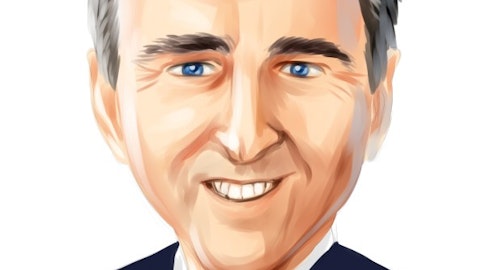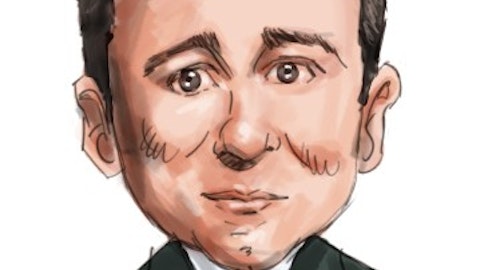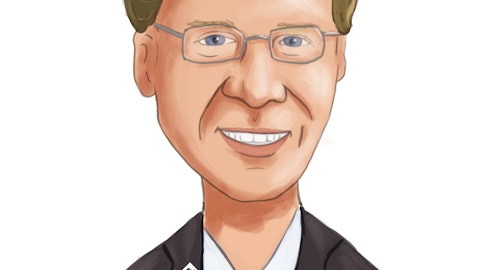First Commonwealth Financial Corporation (NYSE:FCF) Q1 2023 Earnings Call Transcript April 26, 2023
First Commonwealth Financial Corporation misses on earnings expectations. Reported EPS is $0.3 EPS, expectations were $0.39.
Operator: Ladies and gentlemen, good afternoon. My name is Abby, and I will be your conference operator today. At this time, I would like to welcome everyone to the First Commonwealth Financial Corporation First Quarter 2023 Earnings Release Conference Call. Today’s conference is being recorded. And all lines have been placed on mute to prevent any background noise. After the speakers’ remarks, there will be a question-and-answer session. Thank you. And I will now turn the conference over to Ryan Thomas, Vice President of Finance and Investor Relations. You may begin.
Ryan Thomas : Thank you Abby, and good afternoon everyone. Thank you for joining us today to discuss First Commonwealth Financial Corporation’s first quarter financial results. Participating on today’s call will be Mike Price, President and CEO; Jim Reske, Chief Financial Officer; Jane Grebenc, Bank President and Chief Revenue Officer; and Brian Karrip, our Chief Credit Officer. As a reminder a copy of yesterday’s earnings release can be accessed by logging on to fcbanking.com and selecting the Investor Relations link at the top of the page. We’ve also included a slide presentation on our Investor Relations website with supplemental financial information that will be referenced during today’s call. Before we begin we need to caution listeners that this call will contain forward-looking statements.
Please refer to our forward-looking statements disclaimer on Page 3 of the slide presentation for a description of risks and uncertainties that could cause actual results to differ materially from those reflected in the forward-looking statements. Today’s call will also include non-GAAP financial measures. Non-GAAP financial measures should be viewed in addition to and not as an alternative for our reported results prepared in accordance with GAAP. A reconciliation of these measures can be found in the appendix of today’s slide presentation. And with that, I’ll turn it over to Mike.
Mike Price: Thank you Ryan and good afternoon everyone. We are pleased with our results in a tumultuous quarter for the industry. Core earnings per share beat consensus by $0.06. Our NIM expanded. We had record net interest income, and we grew deposits much faster than loans, bringing down our loan-to-deposit ratio. In short, we worked our way through the first quarter by focusing intently on deposit gathering and retention, while taking a measured approach to loan growth. Core earnings per share, which adjusts for one-time merger expenses and the day one CECL provision associated with our acquisition of Centric was $0.45 in the first quarter. Core return on assets of 1.75% was up from 1.51% last quarter reflecting the benefit of lower provision expense, while core pre-tax pre-provision ROA of 2.11% was down from 2.28% last quarter.
The NIM expanded by two basis points to 4.01% and the net interest income was up by $6.3 million over the last quarter. Non-interest income declined and expenses rose contributing to an efficiency ratio that at 52.41% was slightly elevated from last quarter’s 50%. The first quarter was an eventful one for us. We successfully closed and converted Centric Bank during the quarter. The legal close took place on January 31st and the conversion occurred over the last weekend in February. I’m deeply grateful for all of the team members on both sides of this integration who work to make this come together as smoothly as it did. We are bullish on the demographics of the region, which includes Harrisburg, Lancaster and the Philadelphia suburbs of Devon and Doylestown.
We’re also pleased with the former Centric team that joined First Commonwealth, as they have added to our line and back office strength. The events of the first quarter in the banking industry put a spotlight on community banks like First Commonwealth that have diverse and granular deposit portfolios and ample access to liquidity. Looking back to the middle of last year before deposit competition began in earnest our cost of deposits was one of the best of any financial institution in the country. And our time deposit book had been consciously reduced to less than 5% of total deposits. Furthermore, our deposit composition has for some time been balanced between urban and rural and business and consumer with a relatively large proportion of transaction accounts.
As the events of the first quarter unfolded, we saw renewed interest in the composition of that deposit base. I would direct your attention to new disclosures on pages 13 through 17 in the accompanying slide deck. For example, as of the end of the first quarter, our uninsured deposits comprised only 27% of total deposits and our total uninsured unsecured deposits amounted to only 17% of total deposits. Our average deposit size of $19,426 speaks to the granularity of our deposit base. And that figure is for all deposits. Consumer deposits represent 58% of our deposits and the average consumer deposit is $12,726, while the average consumer checking account is $7,900. No one private sector industry represents more than 3% of our deposits. Approximately 98.2% of our deposits are less than $250,000 and 94% are less than $100,000.
We refrained from certain deposit gathering strategies in the fourth quarter in a conscious effort to keep our total assets below $10 billion at quarter end. However, we have always been and continue to be focused on gathering new checking households and acting as the primary depository for our customers. At year-end, in 2022, our total assets were $9.8 billion and we pivoted once again the broader deposit gathering. The results demonstrate the fruit of our efforts as average deposits grew 13.8% annualized, outstripping measured loan growth of 3.43% for the quarter, bringing down our loan-to-deposit ratio from 95.6% to 93.9%. First quarter growth excludes Centric and the impact of purchase accounting marks as consumer loan categories led the way.
We now expect to see mid-single-digit loan growth through the end of the year, in light of our continued ability to generate excess, our capital in excess of what is needed to fund organic loan growth we’re pleased to announce that we have raised the dividend and obtained an additional $25 million of share repurchase authorization from our Board. Our digital platform continues to show impressive growth particularly around customer engagement. We’re now averaging over 210,000 average daily log-ins a 24% year-over-year increase. This equates to approximately 1.2 log-ins per active user per day. As we look to the remainder of 2023 and into 2024 we will remain relentlessly focused on gathering and retaining core deposits. We will realize the benefits of the Centric acquisition and begin to grow.
We will grow our C&I business through our regional business model. And with that I’ll turn it over to Jim Reske our CFO. Jim?
Jim Reske: Thanks, Mike. Net interest income grew by $6.3 million over last quarter to a record $94.7 million. The net interest margin or NIM expanded by two basis points to 4.01% in the quarter as compared to last quarter. The cost of non-maturity deposits was 0.88% in the first quarter for a cumulative through-the-cycle beta of 17.5% to date. Deposit rates increased over the course of the quarter, but at a slowing rate up 31 basis points from January to February but only up 15 basis points from February to March. Our projections for 2023 incorporate a rate forecast that suggests one more 25 basis point rate hike and then a decline in the Fed funds rate to approximately 4.8% by year-end. We estimate roughly five basis points of NIM compression next quarter as always give or take a few basis points.
Our forecasts are highly dependent on assumptions regarding the repricing of deposits. In terms of liquidity, we began the first quarter of 2023 with $285 million of overnight borrowings from the Federal Home Loan Bank. And because deposit growth, exceeded loan growth, we had paid off those borrowings completely towards the middle of March. However in response to industry-wide liquidity concerns, we stockpiled some cash as did many banks this quarter to be sure we have cash on hand of these liquidity needs. At quarter end our cash and available for sale for securities as a percentage of total assets, increased 102 basis points to 10.6%, and total available liquidity of $4.1 billion was 2.6 times total uninsured/unsecured deposits. First quarter average deposits grew at a 13.8% annualized rate, as Mike previously mentioned, excluding the acquisition of Centric Bank.

PTstock/Shutterstock.com
Part of that growth came from the transfer in January, of approximately $109.1 million of average off-balance sheet deposits from our trust company sweep accounts back onto our balance sheet. This was one of the strategies that, as Mike mentioned, we held off on executing in the fourth quarter to avoid inadvertently going over $10 billion in total assets. However, even without this transfer, average deposits would still have grown by 8.3% annualized in the first quarter. The total cost of deposits, which includes non-interest-bearing deposits increased by 52 basis points from 20 basis points last quarter to 73 basis points in the first quarter. The total cost of funds, which includes borrowings, grew by 51 basis points to 90 basis points for the quarter, up 39 basis points from last quarter.
This growth of 51 basis points of the total cost of funds was nearly equal to the 50 basis point increase in the yield on total earning assets in the quarter which helps explain why the NIM was largely unchanged. Fee income declined by $1.3 million, as compared to last quarter, due largely to ongoing weaknesses in our gain on sale businesses. Operating expense increased by $5.8 million as compared to last quarter, as you might expect following an acquisition. Approximately $1.9 million of this expense was directly attributable to Centric operating expense and another $400,000 was the result of increased intangible amortization costs attributable to Centric. And there were other indirect expenses associated with the acquisition such as advertising that are difficult to quantify.
For example, we experienced a $742,000 increase in FDIC deposit insurance premiums in the first quarter, approximately $300,000 of which can be attributable to Centric. Looking forward, we expect intangible amortization expense to total $4.7 million in 2023 with $2.1 million of that coming from the Centric acquisition and we expect operating expense to be in the range of $63 million to $64 million per quarter for the rest of 2023. Core provision expense was a negative $2.7 million that is a release, $2.1 million of which was due to lower reserves on unfunded commitments with the remaining $0.6 million release due to the low level of charge-offs and loan growth, along with a slightly improved Moody’s economic forecast within our CECL model. Centric credit marks came in very close to what we expected, when we announced the transaction.
There was a $10.7 million one-time day one provision expense for Centric as anticipated, but this is excluded from our reported core operating figures. However, including one-time credit marks for Centric, the loan loss reserve will increase from 1.35% of total loans on December 31, to 1.55% of total loans on March 31, 2023 adding further protection to capital. Our non-performing loans reflect the acquisition but credit trends continue to be strong with very low charge-offs, down to 6 basis points from 11 basis points last quarter. I would direct you to new disclosures on Pages 16 through 17 of our supplement to break out our CRE and office loan portfolios. Finally, tangible book value per share increased from $7.92 per share at year-end to $8.13 per share, due to retained earnings and a $13.1 million improvement in AOCI from $137.7 million to $124.6 million.
AOCI is down to 14.8% of tangible common equity from 18.6% last quarter and our tangible common equity ratio remains at 7.8%. I would add that if the fair value marks available for sale and held-to-maturity securities were fully realized, we would remain well capitalized. While we have received an additional $25 million of share repurchase authorization from our Board, as Mike mentioned, we anticipate taking a measured opportunistic approach to buybacks balancing the need to capitalize moderate loan growth and preserve capital with the opportunity to retire shares at these attractive price levels. And with that, we’ll take any questions you may have.
See also 20 Biggest Power Generation Companies in the World and 16 Largest Grocery Chains in the World.
Q&A Session
Follow First Commonwealth Financial Corp (NYSE:FCF)
Follow First Commonwealth Financial Corp (NYSE:FCF)
Operator: Thank you We will take our first question from Frank Schiraldi with Piper Sandler. Your line is open.
Frank Schiraldi: Thanks, good afternoon. Just in terms of the margin detail you gave, on I think you said five basis points of margin contraction, in the second quarter give or take. Seems really strong especially, if you’re still targeting that 25% total deposit beta, I’m not sure if I missed the change there, but is that still the assumption? And can you maybe just talk about, how long you think or when you think that sort of gets fully baked in to the margin?
Jim Reske: Yes. Sure, Frank. We’ve been spending a lot of time working on that and trying to understand that, deposit movements have been so vary this quarter, but it’s difficult to predict. You may recall that a year ago, we dropped our cumulative deposit beta forecast. We have been for some time saying 25% cumulative deposit beta. And then, given the fact that we had almost 0% deposit betas in any — incremental deposit betas in any given quarter last year, we dropped it to 20%. And then towards the end of last year, we said we better go back to 25%. That was our going assumption. Well, we’ve done some work now, to understand where deposits are going and based on current estimates, kind of extrapolating the first quarter deposit trends into the end of the year, we would calculate a deposit beta that’s in the upper 20s, more like 28%.
But it’s impossible to peg even in an exact number like that. May be more helpful, I’d tell you that when we look at it that way, we can say that for every point of cumulative deposit beta, it affects the NIM, the ending NIM for the year by about five basis points. So if you have a 28% cumulative beta, you have one results. And if it ends up being 30% cumulative deposit beta by the end of the year, the margin is 10 points different — 10 points less than that. So, that maybe helps you give you some idea to the sensitivity of the NIM to the betas. But given where things are going, it’s very difficult to predict exactly where deposit behavior is going to take us.
Frank Schiraldi: Okay. I guess, when you think about that 28% or whatever it ends up being, do you sort of feel like that continues maybe for a few quarters after the Fed stops? So maybe, by year-end it’s sort of fully baked in in your analysis?
Jim Reske: Yes. And that’s, a great question. And our analysis actually, tried to only go out one year. It’s difficult to break even several quarters out, let alone going into the next year. So the way, we think about it is a cumulative through-the-cycle beta, taking us to just the end of this year, in a world where the Fed funds comes up a little bit, by another quarter point and then drops down to 4.8% by the end of the year. Even in those results, Frank, when we do a 28% deposit beta, the NIM ends up around in the low 3.90s. And if we stress it and do a 30% cumulative deposit beta, the NIM ends up in the low 3.80s by the end of the year. And that’s why, we’re fairly comfortable saying, five basis points per quarter, but give or take a few at either side because no one really knows where deposits are going.
Frank Schiraldi: Got you. Okay. That’s great color. Thank you. And then just curious, I mean it makes perfect sense. You’re talking about remaining under the $10 billion and the trust sweep balances coming back on in the first quarter. Just curious, what sort of rates those are at? And if you could talk about the growth in the deposit, which was still very strong the growth in deposits at legacy FCF, outside of those sweep balances coming back on in the quarter?
Mike Price: Yes. Jim, why don’t you take the rates and I’ll take the strategies.
Jim Reske: Yes. So, the rates in the trust — so the trust deposits, we hold us in a fiduciary capacity for our trust clients, so there can be no better or worse than it’s softer to the market. So those rates are going to be over — probably over — there are going to be premium rates in the market probably about 4%. So, but no better or worse than they were able to get in their sweep accounts. And so that’s why we’re able — as a fiduciary to bring it back on balance sheet. And Mike, why don’t you take the other question.
Mike Price: Yes. Just our bank President Jane Grebenc, and her Head of Corporate and Retail Banking, they have been laser-focused on a core depository for a decade and it’s taken that long to build it. And we were particularly focused in the first quarter on customer outreach through our branch managers in our commercial RNs, with the competitive rates that Jim mentioned. We’ve rebuilt the CD book. We had let that whittle down to virtually nothing. We have a team that’s really empowered to make exceptions for clients. And we look at a good deposit base of small businesses, corporate client’s, municipalities it’s long tenured deep relationships sticky and granular. And we just look to add to it every month, and that’s a big part of the incentives for our branches, who have a balance sheet and our corporate RMs. So I hope that’s helpful.
Frank Schiraldi: Yeah. No, I appreciate that. And then if I could just sneak in one last one. You mentioned Jim the $63 million to $64 million in operating expense. Any change to the — I think, it was 35% expense saves in the Centric deal? And then when are those fully baked in by? Thanks.
Jim Reske: We had — when we announced that, we projected that those will be fully baked in by the first full year which will be next year but we think we’ll be able to we’re on track to achieve that 35% this year.
Frank Schiraldi: Okay. Great. Thanks.
Mike Price: Thank you.





